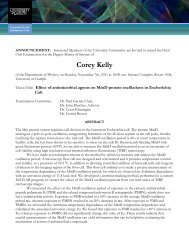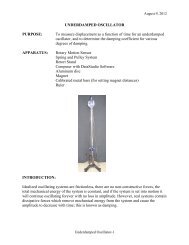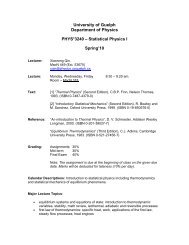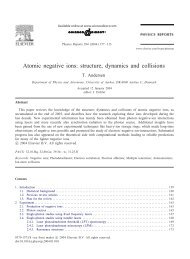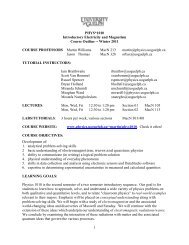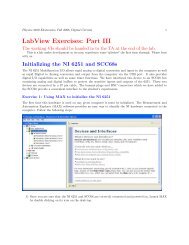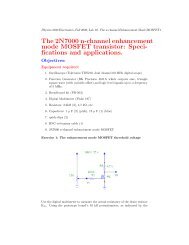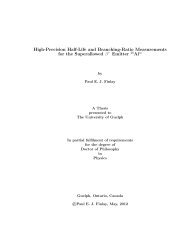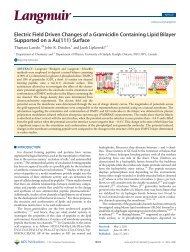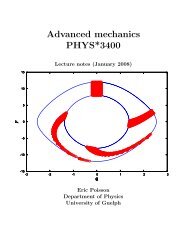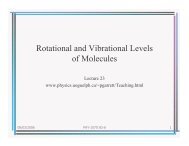Spider Silk: From Soluble Protein to Extraordinary Fiber - Physics
Spider Silk: From Soluble Protein to Extraordinary Fiber - Physics
Spider Silk: From Soluble Protein to Extraordinary Fiber - Physics
You also want an ePaper? Increase the reach of your titles
YUMPU automatically turns print PDFs into web optimized ePapers that Google loves.
Reviews<br />
Table 1: The seven different silks produced by the female orb-weaving spider Araneus diadematus.<br />
<strong>Silk</strong> Origin Mechanical data Sequence data<br />
structural and dragline silk major ampullate silk gland strength: 1.1 GPa [3]<br />
extensibility: 27% [3]<br />
<strong>to</strong>ughness: 180 MJm 3[3]<br />
partial sequence data for<br />
Araneus diadematus and<br />
Nephila clavipes,<br />
complete sequence data for<br />
Latrodectus hesperus [22]<br />
auxiliary spiral thread minor ampullate silk gland n/a partial sequence data from<br />
Nephila clavipes<br />
capture spiral (flagelliform) thread flagelliform silk gland extensibility: 300% [3]<br />
<strong>to</strong>ughness: 150 MJm 3[3]<br />
<strong>to</strong>ugh outer egg case tubulliform and<br />
cylindrical silk gland<br />
soft inner<br />
egg case layer<br />
and wrapping<br />
aciniform silk gland strength: ca. 0.7 GPa [a]<br />
Markus Heim studied biochemistry at the<br />
Technische Universität München, where he<br />
received his M.Sc. in 2006. He is a fellow of<br />
the Graduiertenförderung Universität Bayern<br />
e.V. and is currently working on his PhD<br />
thesis under supervision of Thomas Scheibel<br />
at the University of Bayreuth. His research<br />
focuses on the structure–function relationships<br />
of spider silks and silk-like proteins.<br />
partial sequence data from<br />
Nephila clavipes<br />
n/a partial sequence data from<br />
Latrodectus hesperus<br />
extensibility: 86% [a]<br />
<strong>to</strong>ughness: 250 MJm 3[a]<br />
attachment cement piriform silk gland n/a n/a<br />
sticky aqueous<br />
coating<br />
[a] Data is from Argiope trifasciata.<br />
partial sequence data from<br />
Araneus diadematus and<br />
Argiope trifasciata<br />
aggregate silk gland n/a composition of lowmolecular-mass<br />
compounds<br />
from araneoid spiders, [5]<br />
isolation of two cDNAs for<br />
Latrodectus hesperus [100]<br />
Table 2: Comparison of mechanical properties of Araneus diadematus dragline silk and other well-known natural and synthetic fibers. [a]<br />
Material Density<br />
[gcm 3 ]<br />
Strength<br />
[GPa]<br />
Stiffness<br />
[GPa]<br />
Extensibility<br />
[%]<br />
Toughness<br />
[MJm 3 ]<br />
Specific Properties<br />
T. Scheibel et al.<br />
Araneus diadematus 1.3 1.1 10 27 180 <strong>to</strong>rsional shape memory without external stimulus,<br />
silk (dragline)<br />
[20] reversible<br />
supercontraction (<strong>to</strong> 50% of original length)<br />
Bombyx mori silk<br />
(cocoon)<br />
1.3 0.6 7 18 70 availability (silkworm farming)<br />
elastin 1.3 0.002 0.001 15 2 shape memory when poked or pinched<br />
nylon 6.6 1.1 0.95 5 18 80 high resistance <strong>to</strong> heat and friction [102]<br />
kevlar 49 1.4 3.6 130 2.7 50 high strength-<strong>to</strong>-weight ratio [103]<br />
steel 7.8 1.5 200 0.8 6 versatility (alloying, tempering, swaging)<br />
copper (soft) 8.9 0.2 120 40 – exceptional electrical conductivity<br />
wool (at 100% RH) [b] 1.3 0.2 0.5 5 60 circa 40% water uptake before wet <strong>to</strong> <strong>to</strong>uch,<br />
high ignition temperature<br />
carbon fiber 1.8 4 300 1.3 25 high strength-<strong>to</strong>-weight ratio<br />
[a] If not otherwise mentioned, the data shown are taken from Ref. [101]. [b] RH: relative humidity.<br />
David Keerl studied chemical engineering at<br />
the Technische Universität München, where<br />
he received his Diplom in 2006. He joined<br />
the group of Thomas Scheibel as a PhD<br />
student in August 2006. He is currently<br />
investigating the biomimetic spider silk spinning<br />
process and the mechanical properties<br />
of artificial spider silk materials.<br />
3586 www.angewandte.org 2009 Wiley-VCH Verlag GmbH & Co. KGaA, Weinheim Angew. Chem. Int. Ed. 2009, 48, 3584 – 3596



